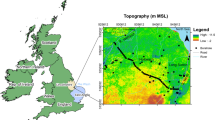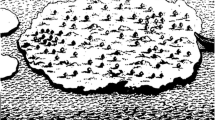Abstract
Animals and plants on low elevation oceanic islands often rely on a thin lens of fresh groundwater and this lens is vulnerable to seawater contamination from storm surge. Documentation of the impact of the storm surge on the freshwater lens and its subsequent recovery is limited. In September 2017, Hurricane Irma made landfall in the Florida Keys as a category 4 storm with storm surge heights in excess of 2 m. This study used Electrical Resistivity Tomography (ERT) to investigate the effect of the storm surge on the freshwater lens of Big Pine Key, FL. The study compared ERT images along three profiles ranging between 220 and 280 m length collected in 2011 with post storm data collected about 3 to 4 months (November 2017/January 2018) and eight (May 2018) months after Irma. The post storm data documented that the storm surge impacted the freshwater lens on all three profiles with low resistivity (i.e., high salinity) zones in the upper 2 m of the groundwater. The increase in salinity was most pronounced in the lower elevations of the profiles. The May 2018 data were collected immediately after 2 weeks of intense precipitation. These data showed 40% recovery of the freshwater lens, most pronounced in the lower elevation of the profiles. This suggests that both the impact of storm surge and the freshwater recovery due to precipitation are most pronounced in low elevation regions where both saline and freshwater can collect at the surface.







Similar content being viewed by others
Notes
The salinity increase was reported in ppt (Lopez et al. 2003)
References
Anderson, W.P., Jr., and R.M. Lauer. 2008. The role of overwash in the evolution of mixing zone morphology within barrier islands. Hydrogeology Journal 16 (8): 1483–1495.
Archie, G.E. 1942. The electrical resistivity log as an aid in determining some reservoir characteristics. Transactions of AIME 146 (01): 54–62.
Bailey, R.T., J.W. Jenson, and A.E. Olsen. 2009. Numerical modeling of atoll island hydrogeology. Groundwater 47 (2): 184–196.
Bender, M.A., T.R. Knutson, R.E. Tuleya, J.J. Sirutis, G.A. Vecchi, S.T. Garner, and I.M. Held. 2010. Modeled impact of anthropogenic warming on the frequency of intense Atlantic hurricanes. Science 327: 454–458.
Berg, R. 2018. Tropical storm Alberto (25–31 May 2018), Tropical Cyclone Reports, National Hurricane Center, https://www.nhc.noaa.gov/data/tcr/AL012018_Alberto.pdf. Accessed 27 Aug 2019.
Binley, A. 2019. R2 (Version 3.3). Lancaster University website: www.es.lancs.ac.uk/people/amb/Freeware/R2/R2.htm. Accessed 20 Mar 2019.
Binley, A., and A. Kemna. 2005. DC Resistivity and Induced Polarization Methods. In Hydrogeophysics. Water Science and Technology Library, ed. Y. Rubin and S.S. Hubbard, 129–156. Dordrecht: Springer.
Cangialosi, J. P., A. S. Latto, and R. Berg. 2018. Hurricane Irma (30 August–12 September 2017). Tropical Cyclone Reports, National Hurricane Center, https://www.nhc.noaa.gov/data/tcr/AL112017_Irma.pdf. Accessed 8 Aug 2019.
Caterina, D., A.F. Orozco, and F. Nguyen. 2017. Long-term ERT monitoring of biogeochemical changes of an aged hydrocarbon contamination. Journal of Contaminant Hydrology 201: 19–29.
Chang, S.W., T.P. Clement, M.J. Simpson, and K.K. Lee. 2011. Does sea-level rise have an impact on saltwater intrusion? Advances in Water Resources 34 (10): 1283–1291.
Chui, T.F.M., and J.P. Terry. 2012. Modeling fresh water lens damage and recovery on atolls after storm-wave washover. Groundwater 50 (3): 412–420.
Church, J. A., and N. J. White. 2006. A 20th century acceleration in global sea-level rise. Geophysical Research Letters 33(1).
Constable, S.C., R.L. Parker, and C.G. Constable. 1987. Occam’s inversion: a practical algorithm for generating smooth models from electromagnetic sounding data. Geophysics 52 (3): 289–300.
De Franco, R., G. Biella, L. Tosi, P. Teatini, A. Lozej, B. Chiozzotto, and V. Bassan. 2009. Monitoring the saltwater intrusion by time lapse electrical resistivity tomography: Tthe Chioggia test site (Venice Lagoon, Italy). Journal of Applied Geophysics 69 (3–4): 117–130.
Falkland, A., and E. Custodio. 1991. Conditions for freshwater occurrence in small islands. In Hydrology and Water Resources of Small Islands: A practical guide: A contribution to the international hydrological programme, IHP-III, Project 4.6, eds, ed. A. Falkland, E. Custodio, A. Diaz Arenas, and L. Simler, 27–43. Paris: UNESCO.
Fish, J. E., and M.T. Stewart. 1991. Hydrogeology of the surficial aquifer system, Dade County, Florida. U.S. Geological Survey Water-Resources Investigations Report 90-4108. https://doi.org/10.3133/wri904108.
Goebel, M., A. Pidlisecky, and R. Knight. 2017. Resistivity imaging reveals complex pattern of saltwater intrusion along Monterey coast. Journal of Hydrology 551: 746–755.
Halley, R.B., H.L. Vacher, and E.A. Shinn. 1997. Geology and hydrogeology of the Florida Keys. In Geology and hydrogeology of carbonate islands, ed. H.L. Vacher and T.M. Quinn, 217–248. Amsterdam: Elsevier.
Hanson, C. E. 1980. Freshwater resources of Big Pine Key, Florida. U.S. Geological Survey Open-File Report 80–447. https://doi.org/10.3133/ofr80447
Holding, S., and D.M. Allen. 2015. Wave overwash impact on small islands: generalised observations of freshwater lens response and recovery for multiple hydrogeological settings. Journal of Hydrology 529: 1324–1335.
Horel, J., M. Splitt, L. Dunn, J. Pechmann, B. White, C. Ciliberti, and J. Burks. 2002. Mesowest: Cooperative mesonets in the western United States. Bulletin of the American Meteorological Society 83 (2): 211–226.
Huizer, S., M.C. Karaoulis, G.H.P. Oude Essink, and M.F.P. Bierkens. 2017. Monitoring and simulation of salinity changes in response to tide and storm surges in a sandy coastal aquifer system. Water Resources Research 53 (8): 6487–6509.
Keim, B.D., R.A. Muller, and G.W. Stone. 2007. Spatiotemporal patterns and return periods of tropical storm and hurricane strikes from Texas to Maine. Journal of Climate 20 (14): 3498–3509.
Kemna, A., J. Vanderborght, B. Kulessa, and H. Vereecken. 2002. Imaging and characterisation of subsurface solute transport using electrical resistivity tomography (ERT) and equivalent transport models. Journal of Hydrology 267 (3-4): 125–146.
LaBrecque, D.J., and X. Yang. 2001. Difference inversion of ERT data: a fast inversion method for 3-D in situ monitoring. Journal of Environmental and Engineering Geophysics 6 (2): 83–89.
Langevin, C.D., M.T. Stewart, and C.M. Beaudoin. 1998. Effects of sea water canals on fresh water resources: an example from Big Pine Key, Florida. Ground Water 36 (3): 503–513.
Lopez, R.R., N.J. Silvy, R.F. Labisky, and P.A. Frank. 2003. Hurricane impacts on Key deer in the Florida Keys. The Journal of Wildlife Management 67 (2): 280–288.
Morgan, L.K., and A.D. Werner. 2014. Seawater intrusion vulnerability indicators for freshwater lenses in strip islands. Journal of Hydrology 508: 322–327.
Neal, A., M. Grasmueck, D.F. McNeill, D.A. Viggiano, and G.P. Eberli. 2008. Full-resolution 3D radar stratigraphy of complex oolitic sedimentary architecture: Miami Limestone, Florida, U.S.A. Journal of Sedimentary Research 78 (9): 638–653.
NOAA, NCDC. 2018. NOAA National Centers for Environmental Information (NCEI). https://www.ncdc.noaa.gov/. Accessed 8 Aug 2019.
Nowroozi, A.A., S.B. Horroceos, and P. Henderson. 1999. Saltwater intrusion into the freshwater aquifer in the eastern shore of Virginia: a reconnaissance electrical resistivity survey. Journal of Applied Geophysics 42 (1): 1–22.
Ogurcak, D.E. 2015. The effect of disturbance and freshwater availability on lower Florida Keys’ coastal forest dynamics. FIU Electronic Theses and Dissertations. 2288 http://digitalcommons.fiu.edu/etd/2288.
Ogurcak, D.E., and R. Price. 2018. Groundwater geochemistry fluctuations along a fresh-saltwater gradient on the carbonate islands of the lower Florida Keys. Chemical Geology. https://doi.org/10.1016/j.chemgeo.2018.09.032.
Oldenburg, D.W., and Y. Li. 1999. Estimating depth of investigation in dc resistivity and IP surveys. Geophysics 64 (2): 403–416.
Pasch, R.J., L.A. Avila, J.L. Guiney, and J. 2001. Atlantic hurricane season of 1998. Monthly Weather Review 129 (12): 3085–3123.
Pasch, R. J., E. S. Blake, H. D. Cobb III, and D. P. Roberts. 2006. Hurricane Wilma (15–25 October 2005). Tropical cyclone report: National Hurricane Center. https://www.nhc.noaa.gov/data/tcr/AL252005_Wilma.pdf. Accessed 8 Aug 2019.
Ranjan, P., S. Kazama, and M. Sawamoto. 2006. Effects of climate change on coastal fresh groundwater resources. Global Environmental Change 16 (4): 388–399.
Robins, N.S., and A.R. Lawrence. 2000. Some hydrogeological peculiar to various types of problems small islands. Water Environment Journal 14 (5): 341–346.
Rosales, R., P. Martínez-Pagan, A. Faz, and J. Moreno-Cornejo. 2012. Environmental monitoring using electrical resistivity tomography (ERT) in the subsoil of three former petrol stations in SE of Spain. Water, Air, and Soil Pollution 223 (7): 3757–3773.
Ross, M.S., J.J. O’Brien, and L.J. Flynn. 1992. Ecological site classification of Florida Keys terrestrial habitats. Biotropica 24 (4): 488–502.
Ross, M.S., J.J. O’Brien, R.G. Ford, K. Zhang, and A. Morkill. 2009. Disturbance and the rising tide: the challenge of biodiversity management on low-island ecosystems. Frontiers in Ecology and the Environment 7 (9): 471–478.
Ross, M.S., D.E. Ogurcak, S. Stoffella, J.P. Sah, J. Hernandez, and H.E. Willoughby. 2019. Hurricanes, storm surge, and Pine forest decline on a low limestone Island. Estuaries and Coasts. https://doi.org/10.1007/s12237-019-00624-z.
Saha, A.K., S. Saha, J. Sadle, J. Jiang, M.S. Ross, R.M. Price, and K.S. Wendelberger. 2011. Sea level rise and South Florida coastal forests. Climatic Change 107 (1-2): 81–108.
Scott T. M. 2001. Text to accompany the geologic map of Florida. Florida Geological Survey Open File Report 80.
Simyrdanis, K., N. Papadopoulos, P. Soupios, S. Kirkou, and P. Tsourlos. 2018. Characterization and monitoring of subsurface contamination from olive oil mills’ waste waters using electrical resistivity tomography. Science of the Total Environment 637: 991–1003.
Stewart, M. 1988. Electromagnetic mapping of fresh-water lenses on small oceanic islands. Groundwater 26 (2): 187–191.
Terry, J.P., and A.C. Falkland. 2010. Responses of atoll freshwater lenses to storm-surge overwash in the Northern Cook islands. Hydrogeology Journal 18 (3): 749–759.
Tucker, N. M. 2013. Analyzing tidal fluctuations in the Big Pine Key freshwater lens with time-lapse resistivity. FIU Electronic Theses and Dissertations. Paper 947. http://digitalcommons.fiu.edu/etd/947.
USGS 2017. USGS measures the impacts of Hurricane Irma. U.S. Geological Survey. https://www.usgs.gov/news/usgs-measures-impacts-hurricane-irma. Accessed 14 Aug 2019.
Van Biersel, T.P., D.A. Carlson, and L.R. Milner. 2007. Impact of hurricanes storm surges on the groundwater resources. Environmental Geology 53 (4): 813–826.
Villholth, K.G., P. Amerasinghe, and P. Jeyakumar. 2008. Tsunami impacts on shallow groundwater and associated water supplies on the east coast of Sri Lanka. In Groundwater for sustainable development: problems, perspectives and challenges, ed. P. Bhattacharya, A.L. Ramanathan, A.B. Mukherjee, J. Bundschuh, D. Chandrasekharam, and A.K. Keshari, 211–222. London: Taylor and Francis Publications.
Wagner, R.J., R.W. Boulger Jr., C.J. Oblinger, and B. Smith. 2006. Guidelines and standard procedures for continuous water-quality monitors: station operation, record computation, and data reporting: Techniques and Methods. 1-D3. U.S. Geological Survey. https://doi.org/10.3133/tm1D3.
Wightman, M. J. 1990. Geophysical analysis and Dupuit-Ghyben-Herzberg modeling of fresh-water lenses on Big Pine Key, Florida. M.S Thesis, University of South Florida, Tampa FL, USA.
Xian, S., K. Feng, N. Lin, R. Marsooli, D. Chavas, J. Chen, and A. Hatzikyriakou. 2018. Brief communication: rapid assessment of damaged residential buildings in the Florida Keys after Hurricane Irma. Natural Hazards and Earth System Sciences 18: 2041–2045.
Yang, J., T. Graf, and T. Ptak. 2015. Sea level rise and storm surge effects in a coastal heterogeneous aquifer: a 2D modelling study in northern Germany. Grundwasser 20 (1): 39–51.
Zohdy, A.A.R., P.M. Martin, and R.J. Bisdorf. 1993. A study of seawater intrusion using direct-current soundings in the southeastern part of the Oxnard Plain, 93–524. California: Geological Survey Open-File Report. https://doi.org/10.3133/ofr93524.
Acknowledgements
We wish to extend our appreciation to Andrew Binley for making R2 software freely available and Nicole M. Tucker, Alejandro Garcia and Himadri Biswas who contributed to the data acquisition. Comments by the anonymous reviewers and editors substantially improved the manuscript. This is contribution number 931 from the Southeast Environmental Research Center in the Institute of Water and Environment at Florida International University.
Funding
This research was funded by the National Fish and Wildlife Foundation and administered by the US Fish and Wildlife Service (USFWS) National Key Deer Refuge (Cooperative Agreement Award No. F18AC00088).
Author information
Authors and Affiliations
Corresponding author
Additional information
Communicated by David Reide Corbett
Rights and permissions
About this article
Cite this article
Kiflai, M.E., Whitman, D., Ogurcak, D.E. et al. The Effect of Hurricane Irma Storm Surge on the Freshwater Lens in Big Pine Key, Florida using Electrical Resistivity Tomography. Estuaries and Coasts 43, 1032–1044 (2020). https://doi.org/10.1007/s12237-019-00666-3
Received:
Revised:
Accepted:
Published:
Issue Date:
DOI: https://doi.org/10.1007/s12237-019-00666-3




